1 of 15
Downloaded 28 times
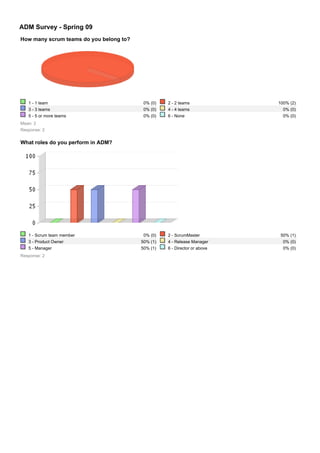


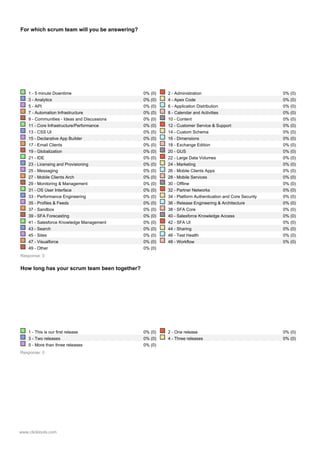
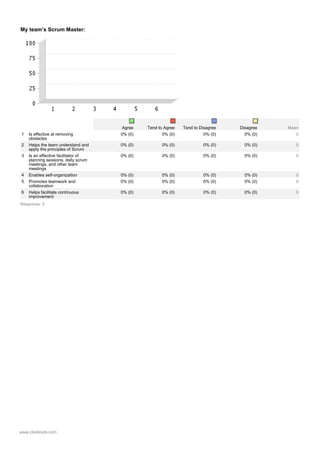
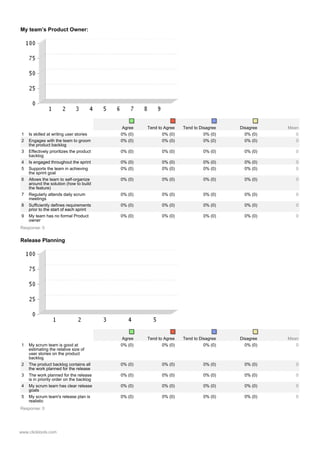
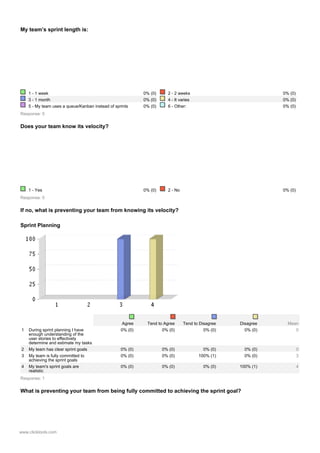
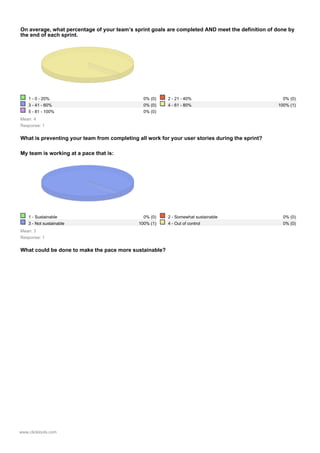


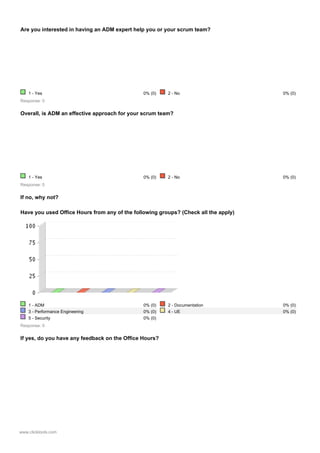

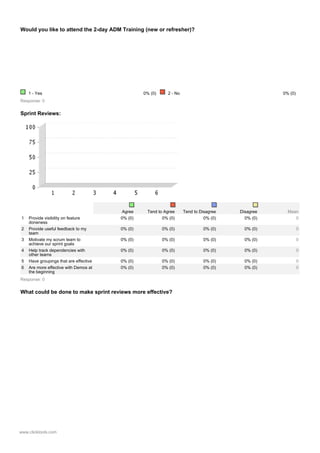
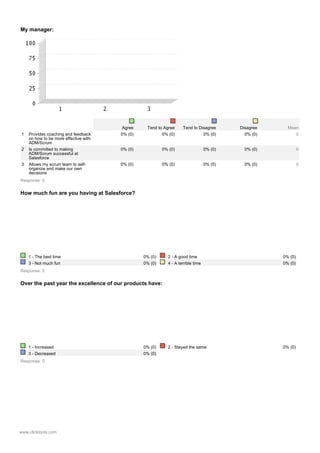

Ad
Recommended
Large Scale Agile Transformation in an On-Demand World
Large Scale Agile Transformation in an On-Demand WorldSteve Greene
╠²
Salesforce.com underwent a major agile transformation, shifting a 200-person team from a waterfall methodology to an agile process to improve release cycles and product quality. The transition was facilitated through a comprehensive training program, a dedicated cross-functional rollout team, and a commitment to transparency and continuous improvement. Key outcomes included increased team efficiency, successful major releases, and significant reductions in product bugs.Successfully Scaling an Agile Innovation Culture with Perforce - 2011 Perforc...
Successfully Scaling an Agile Innovation Culture with Perforce - 2011 Perforc...Steve Greene
╠²
This document discusses how Salesforce successfully scaled an agile innovation culture using Perforce. It describes how Salesforce underwent a major enterprise-wide transformation to an Adaptive Delivery Methodology (ADM) over 3 months. Key aspects of ADM include using Scrum, XP practices, lean principles, self-organizing teams, continuous integration, and time-boxed iterations. The transformation focused on maintaining a single codeline, investing heavily in automation, and ensuring a predictable monthly release rhythm through radical transparency with metrics.Dreamforce 2010 - Agile Development for Force.com
Dreamforce 2010 - Agile Development for Force.comSteve Greene
╠²
ADM is Salesforce's agile development methodology that employs Scrum, extreme programming practices, and lean principles. It aims to eliminate waste, build in quality, respect people, optimize the whole system, create knowledge, make just-in-time decisions, and deliver features fast to ensure on-time and high-quality innovation. The presentation provided an overview of ADM and encouraged attendees to visit the Developer Training and Support Booth to learn more about developer certifications, learning paths, and resources.Transforming Your Organization to Agile
Transforming Your Organization to AgileSteve Greene
╠²
This document discusses how salesforce.com transformed from a traditional waterfall development process to an agile development process. It describes how salesforce.com took a "big bang" approach and converted its entire R&D team to agile development over a short period of time. This transition improved transparency, energy, productivity, and delivery schedules. It also discusses how salesforce.com built an internal agile project management tool called Scrumforce and how CA later commercialized this concept into its Agile Vision product to help other companies adopt agile development practices at scale.Agile Development Meets Cloud Computing for Extraordinary Results at Salesfor...
Agile Development Meets Cloud Computing for Extraordinary Results at Salesfor...Steve Greene
╠²
Agile development practices have helped Salesforce.com dramatically improve its software development process and deliver new releases on time. By adopting agile methods, Salesforce.com increased its release rate, reduced time to market for major releases by 61%, and improved customer satisfaction and developer productivity. The cloud computing platform allowed Salesforce.com to fully realize the benefits of agile development by facilitating rapid and continuous delivery of new features based on customer and developer feedback.Dreamforce Executive Summit - Accelerating Innovation and Growth
Dreamforce Executive Summit - Accelerating Innovation and GrowthSteve Greene
╠²
The document discusses how companies can accelerate innovation and enable growth in the current business environment, referred to as the "New Normal". It covers key themes of the New Normal, leading transformation, leveraging cloud technologies, and innovating to grow. Specific strategies proposed include thinking big with disruptive approaches, inspiring visions, and agile methodologies. The cloud is seen as enabling continuous innovation through multi-tenant platforms and painless upgrades. The goal is disruptive innovation that leads to transformational results for companies.Stanford Case Study - Salesforce.com Transformation
Stanford Case Study - Salesforce.com TransformationSteve Greene
╠²
This document summarizes the development challenges facing Salesforce.com in 2006. Steve Greene and Chris Fry proposed a new agile development process to address slowing release cycles and morale issues. However, their VP Harris mandated implementing the new process company-wide instead of starting with a pilot. The existing "waterfall" process was no longer working as revenues grew over 80% annually but releases slowed to once per year. Salesforce.com aimed to maintain innovation as it grew from a disruptive startup into a larger company serving a growing market for cloud-based enterprise software.Comparing Agile transformation approaches at Twitter and Salesforce
Comparing Agile transformation approaches at Twitter and SalesforceSteve Greene
╠²
This document discusses strategies for transforming a large organization to an agile methodology. It recommends starting with a "big bang" approach, where all teams transition together using Scrum. The transformation is driven from the top down but implemented bottom up. Teams are reorganized into self-organizing cross-functional teams with dedicated resources. The transformation focuses on iterative development, continuous delivery, and establishing core values like transparency. Coaching and training help drive adoption. Initial results include improved productivity, predictability, and executive buy-in. Advice includes focusing on principles over mechanics and getting early engineer involvement.Agile 2010 conference - a holistic approach to scaling agile at salesforce
Agile 2010 conference - a holistic approach to scaling agile at salesforceSteve Greene
╠²
The document summarizes Salesforce.com's approach to scaling agile practices across multiple teams and departments. It discusses problems they initially faced with unpredictability and lack of visibility. It then outlines their Adaptive Delivery Methodology (ADM) framework used to scale agile principles through over 100 teams. Some challenges in wide scaling included dependencies, aggressive hiring, and maintaining team focus. Solutions involved tools to help coordination, investing in collaboration, and hiring for culture fit.Dreamforce 2009: IT Success with Agile Development Processes
Dreamforce 2009: IT Success with Agile Development ProcessesSteve Greene
╠²
The document outlines a presentation by Salesforce executives about the company's experiences with agile development processes, particularly the Adaptive Delivery Methodology (ADM). It discusses challenges faced in achieving predictable project completion and the transformation results achieved through agile practices. Key takeaways emphasize the benefits of ADM in enhancing project visibility, partner relationships, and operational efficiency.Dreamforce 2009: Behind-the-Scenes at Salesforce.com: Delivering 3 Major Rele...
Dreamforce 2009: Behind-the-Scenes at Salesforce.com: Delivering 3 Major Rele...Steve Greene
╠²
Salesforce.com delivers 3 major releases per year using an Agile development methodology called ADM. ADM employs Scrum project management and some extreme programming practices based on lean principles such as eliminating waste, building in quality, respecting people, optimizing the whole system, and just-in-time decision making. This allows Salesforce.com to deliver high quality software on a monthly rhythm. The panel discussed how Salesforce.com is able to effectively coordinate development across its platform and core products to achieve this rapid release cadence.Weird Myths In Business
Weird Myths In BusinessSteve Greene
╠²
The document lists various common myths and misconceptions that are often believed in business. Some examples include the ideas that the boss always has the best ideas, ambiguity should be eliminated before starting a project, and that creativity does not scale in business. Overall, the document seems to critique commonly held beliefs in management and suggest that some practices may not be as effective as commonly thought.Unleashing The Fossa Agile Leadership Summit 2009
Unleashing The Fossa Agile Leadership Summit 2009Steve Greene
╠²
The document summarizes the scaling of agile practices at Salesforce.com. It describes how Salesforce transformed to an Agile Development Methodology (ADM) to address issues like lack of visibility, resource bottlenecks, and unpredictable project completion that arose from rapid growth. Key results of adopting ADM included increasing features delivered per team, reducing time between major releases, and delivering projects on time. The transformation was company-wide and involved training, coaching, tools, and policies to establish processes for release planning, dependency identification, concept reviews, and a virtual architecture team to facilitate cross-team collaboration at scale.Dependency Management In A Large Agile Environment
Dependency Management In A Large Agile EnvironmentSteve Greene
╠²
The document summarizes dependency management practices at Salesforce.com for their large agile development environment with over 30 Scrum teams. Key practices include a release kickoff meeting to share team plans, a dependency identification exercise to map dependencies, release open space discussions, functional design reviews, a virtual architecture team, continuous integration processes, and allocating team time to address dependencies. These practices aim to improve visibility, collaboration and coordination across teams.Q Con 2008 - Unleashing the Fossa
Q Con 2008 - Unleashing the FossaSteve Greene
╠²
1) Salesforce.com underwent a major enterprise-wide transformation to Agile Development Methodology (ADM) in 2006 to address issues like lack of visibility, unpredictable project completion, and infrequent customer feedback that were hindering their ability to deliver major releases regularly.
2) The transition was challenging initially and faced resistance from employees, but eventually led to significant improvements like a 61% reduction in time between major releases and a 38% increase in features delivered per developer.
3) ADM combines Scrum, XP practices, and lean principles and emphasizes transparency, iterative development, customer feedback, and continuous improvement - which helped Salesforce.com scale Agile successfully across their large organization.Dreamforce 2008 : Transforming IT Success with Agile Development Processes
Dreamforce 2008 : Transforming IT Success with Agile Development ProcessesSteve Greene
╠²
The document discusses how salesforce.com transformed its IT processes using agile development methods. It summarizes the challenges they faced with previous development approaches, including lack of visibility, resource bottlenecks, and unpredictable project timelines. It then describes how they implemented an agile methodology called ADM, with practices like scrum, time-boxing, self-organizing teams, and frequent customer feedback. The results were significant increases in features delivered and reduced time between major releases. Lessons learned include how agile provided competitive advantages and how large transformations can accelerate returns.Agile Leadership Summit: Unleashing The Fossa : Scaling Agile in an Ambitious...
Agile Leadership Summit: Unleashing The Fossa : Scaling Agile in an Ambitious...Steve Greene
╠²
The document summarizes the transition of salesforce.com from a traditional waterfall development process to an agile development process called ADM (Agile Development Methodology) over a 3 year period from 2006 to 2009. It describes how salesforce.com grew rapidly initially with a small R&D team but faced challenges in on-time delivery as the company scaled. To address these challenges, salesforce.com underwent an enterprise-wide transformation to ADM which resulted in a 61% improvement in release frequency and 38% increase in features delivered per developer. The transformation process involved training employees and overcoming resistance to change, with continuous improvements made over several years.Dreamforce 2008 : Behind-the-Scenes @ Salesforce.com R&D: How We Deliver 3 Ma...
Dreamforce 2008 : Behind-the-Scenes @ Salesforce.com R&D: How We Deliver 3 Ma...Steve Greene
╠²
The document discusses Salesforce's delivery process for three major releases annually, highlighting their adaptive delivery methodology (ADM) which employs agile practices like SCRUM. It outlines the benefits of this approach, including improved project visibility, team alignment, and timely releases. Additionally, it includes a safe harbor statement regarding potential risks associated with forward-looking statements and invites feedback on the presentation.Scrum Gathering 2008 Stockholm - Salesforce.com
Scrum Gathering 2008 Stockholm - Salesforce.comSteve Greene
╠²
Salesforce.com underwent a major enterprise-wide transformation to Agile Development Methodology (ADM) over 3 months in order to address issues like a lack of visibility, resource bottlenecks, and unpredictable release dates that were causing customer unhappiness and a decline in productivity. This "Big Bang" approach resulted in significant improvements like a 61% reduction in time between major releases, a 94% increase in delivered feature requests, and a 38% increase in features delivered per developer. While the transition was challenging and faced some initial resistance, continuous improvements and refinements over time helped ensure the success and sustainability of the new Agile approach.Writing within an Agile Development Environment
Writing within an Agile Development EnvironmentSteve Greene
╠²
The document discusses writing within an agile development environment. It provides an overview of what agile is and is not, compared to traditional phased development processes. It then summarizes the challenges of writing documentation within rapid agile cycles. Finally, it outlines strategies salesforce.com has found effective for technical writing in agile, and the benefits this approach provides to both writers and the development process.The Doctor is ŌĆ£InŌĆØ : Using the Office Hours Concept to Make Limited Resources...
The Doctor is ŌĆ£InŌĆØ : Using the Office Hours Concept to Make Limited Resources...Steve Greene
╠²
The document discusses using an "office hours" concept to make limited resources most effective at an Agile 2008 conference presentation by Andrea Leszek and Catherine Courage. It includes a standard safe harbor statement for any forward-looking statements made during the presentation under securities law. The presentation aims to discuss strategies and plans for efficiently utilizing resources through setting dedicated "office hours" times.Dependency Management In A Large Agile Organization
Dependency Management In A Large Agile OrganizationSteve Greene
╠²
This document discusses dependency management in a large agile organization. It was presented at the Agile 2008 conference in Toronto by Eric Babinet and Rajani Ramanathan. The document contains a safe harbor statement noting that any projections or statements regarding future strategies, plans, beliefs, services, technology or customer contracts constitute forward-looking statements that may differ from actual results.FAST & PREDICTABLE : Lightweight Release Framework promotes Rhythm & Flow
FAST & PREDICTABLE : Lightweight Release Framework promotes Rhythm & FlowSteve Greene
╠²
A lightweight release framework called FAST promotes agility through rhythm and flow. It was presented at the Agile 2008 conference in Toronto by Amy Farrow and Steve Greene. Their presentation included a standard safe harbor statement noting that any forward-looking statements in the presentation involve risks, uncertainties, and assumptions that could cause actual results to differ from expectations.Postcard Patterns : An Agile User Interface Pattern Creation Process
Postcard Patterns : An Agile User Interface Pattern Creation ProcessSteve Greene
╠²
The document discusses an agile user interface pattern creation process used by Salesforce. It describes challenges with an earlier pattern library and outlines a new approach using simple "postcard" style patterns that can be created and iterated on quickly in collaboration with various teams. The new process focuses on visual documentation over lengthy text and aims to improve communication, reuse, and onboarding through an accessible online pattern library.Blue
BlueSteve Greene
╠²
This document discusses different sources for finding blue-colored images online. It mentions searching Google Images, Flickr, and iStockPhoto as well as checking a personal photo collection for pictures that are blue in color or that the author particularly likes.Tips n' Tricks - Sprint Review
Tips n' Tricks - Sprint ReviewSteve Greene
╠²
The document provides tips for effective sprint reviews, emphasizing the importance of visibility, stakeholder engagement, and storytelling during demos. It outlines who should participate in the review and what to present, including a prioritized list of stories for the next sprint, while cautioning against common mistakes. Key recommendations focus on preparation, audience engagement, and clear communication to make the demo impactful.Death by Project (and the simple choice)
Death by Project (and the simple choice)Steve Greene
╠²
The document compares a project-based model to a team-based model for organizing work. In the project-based model, project teams are created for each project and disband upon completion, leading to context switching, inconsistent work flows, and complex resource management. The team-based model uses self-organized, cross-functional teams with dedicated resources that own domains of work across multiple projects and prioritize work from a backlog, allowing for more consistent delivery, greater predictability, and happier customers and teams. The team-based model provides a simpler structure that flows work more effectively.ADM Overview - Customers
ADM Overview - CustomersSteve Greene
╠²
The document describes an adaptive development methodology called ADM that is based on Scrum and XP principles. ADM employs a Scrum project management framework, adopts certain XP practices, and is tailored specifically for product development at Salesforce. It focuses on principles like iterative development, self-organizing teams, prioritized backlogs, and delivering working software frequently through short development cycles.The Future of AI Agent Development Trends to Watch.pptx
The Future of AI Agent Development Trends to Watch.pptxLisa ward
╠²
The Future of AI Agent Development: Trends to Watch explores emerging innovations shaping smarter, more autonomous AI solutions for businesses and technology.
9-1-1 Addressing: End-to-End Automation Using FME
9-1-1 Addressing: End-to-End Automation Using FMESafe Software
╠²
This session will cover a common use case for local and state/provincial governments who create and/or maintain their 9-1-1 addressing data, particularly address points and road centerlines. In this session, you'll learn how FME has helped Shelby County 9-1-1 (TN) automate the 9-1-1 addressing process; including automatically assigning attributes from disparate sources, on-the-fly QAQC of said data, and reporting. The FME logic that this presentation will cover includes: Table joins using attributes and geometry, Looping in custom transformers, Working with lists and Change detection.More Related Content
More from Steve Greene (20)
Agile 2010 conference - a holistic approach to scaling agile at salesforce
Agile 2010 conference - a holistic approach to scaling agile at salesforceSteve Greene
╠²
The document summarizes Salesforce.com's approach to scaling agile practices across multiple teams and departments. It discusses problems they initially faced with unpredictability and lack of visibility. It then outlines their Adaptive Delivery Methodology (ADM) framework used to scale agile principles through over 100 teams. Some challenges in wide scaling included dependencies, aggressive hiring, and maintaining team focus. Solutions involved tools to help coordination, investing in collaboration, and hiring for culture fit.Dreamforce 2009: IT Success with Agile Development Processes
Dreamforce 2009: IT Success with Agile Development ProcessesSteve Greene
╠²
The document outlines a presentation by Salesforce executives about the company's experiences with agile development processes, particularly the Adaptive Delivery Methodology (ADM). It discusses challenges faced in achieving predictable project completion and the transformation results achieved through agile practices. Key takeaways emphasize the benefits of ADM in enhancing project visibility, partner relationships, and operational efficiency.Dreamforce 2009: Behind-the-Scenes at Salesforce.com: Delivering 3 Major Rele...
Dreamforce 2009: Behind-the-Scenes at Salesforce.com: Delivering 3 Major Rele...Steve Greene
╠²
Salesforce.com delivers 3 major releases per year using an Agile development methodology called ADM. ADM employs Scrum project management and some extreme programming practices based on lean principles such as eliminating waste, building in quality, respecting people, optimizing the whole system, and just-in-time decision making. This allows Salesforce.com to deliver high quality software on a monthly rhythm. The panel discussed how Salesforce.com is able to effectively coordinate development across its platform and core products to achieve this rapid release cadence.Weird Myths In Business
Weird Myths In BusinessSteve Greene
╠²
The document lists various common myths and misconceptions that are often believed in business. Some examples include the ideas that the boss always has the best ideas, ambiguity should be eliminated before starting a project, and that creativity does not scale in business. Overall, the document seems to critique commonly held beliefs in management and suggest that some practices may not be as effective as commonly thought.Unleashing The Fossa Agile Leadership Summit 2009
Unleashing The Fossa Agile Leadership Summit 2009Steve Greene
╠²
The document summarizes the scaling of agile practices at Salesforce.com. It describes how Salesforce transformed to an Agile Development Methodology (ADM) to address issues like lack of visibility, resource bottlenecks, and unpredictable project completion that arose from rapid growth. Key results of adopting ADM included increasing features delivered per team, reducing time between major releases, and delivering projects on time. The transformation was company-wide and involved training, coaching, tools, and policies to establish processes for release planning, dependency identification, concept reviews, and a virtual architecture team to facilitate cross-team collaboration at scale.Dependency Management In A Large Agile Environment
Dependency Management In A Large Agile EnvironmentSteve Greene
╠²
The document summarizes dependency management practices at Salesforce.com for their large agile development environment with over 30 Scrum teams. Key practices include a release kickoff meeting to share team plans, a dependency identification exercise to map dependencies, release open space discussions, functional design reviews, a virtual architecture team, continuous integration processes, and allocating team time to address dependencies. These practices aim to improve visibility, collaboration and coordination across teams.Q Con 2008 - Unleashing the Fossa
Q Con 2008 - Unleashing the FossaSteve Greene
╠²
1) Salesforce.com underwent a major enterprise-wide transformation to Agile Development Methodology (ADM) in 2006 to address issues like lack of visibility, unpredictable project completion, and infrequent customer feedback that were hindering their ability to deliver major releases regularly.
2) The transition was challenging initially and faced resistance from employees, but eventually led to significant improvements like a 61% reduction in time between major releases and a 38% increase in features delivered per developer.
3) ADM combines Scrum, XP practices, and lean principles and emphasizes transparency, iterative development, customer feedback, and continuous improvement - which helped Salesforce.com scale Agile successfully across their large organization.Dreamforce 2008 : Transforming IT Success with Agile Development Processes
Dreamforce 2008 : Transforming IT Success with Agile Development ProcessesSteve Greene
╠²
The document discusses how salesforce.com transformed its IT processes using agile development methods. It summarizes the challenges they faced with previous development approaches, including lack of visibility, resource bottlenecks, and unpredictable project timelines. It then describes how they implemented an agile methodology called ADM, with practices like scrum, time-boxing, self-organizing teams, and frequent customer feedback. The results were significant increases in features delivered and reduced time between major releases. Lessons learned include how agile provided competitive advantages and how large transformations can accelerate returns.Agile Leadership Summit: Unleashing The Fossa : Scaling Agile in an Ambitious...
Agile Leadership Summit: Unleashing The Fossa : Scaling Agile in an Ambitious...Steve Greene
╠²
The document summarizes the transition of salesforce.com from a traditional waterfall development process to an agile development process called ADM (Agile Development Methodology) over a 3 year period from 2006 to 2009. It describes how salesforce.com grew rapidly initially with a small R&D team but faced challenges in on-time delivery as the company scaled. To address these challenges, salesforce.com underwent an enterprise-wide transformation to ADM which resulted in a 61% improvement in release frequency and 38% increase in features delivered per developer. The transformation process involved training employees and overcoming resistance to change, with continuous improvements made over several years.Dreamforce 2008 : Behind-the-Scenes @ Salesforce.com R&D: How We Deliver 3 Ma...
Dreamforce 2008 : Behind-the-Scenes @ Salesforce.com R&D: How We Deliver 3 Ma...Steve Greene
╠²
The document discusses Salesforce's delivery process for three major releases annually, highlighting their adaptive delivery methodology (ADM) which employs agile practices like SCRUM. It outlines the benefits of this approach, including improved project visibility, team alignment, and timely releases. Additionally, it includes a safe harbor statement regarding potential risks associated with forward-looking statements and invites feedback on the presentation.Scrum Gathering 2008 Stockholm - Salesforce.com
Scrum Gathering 2008 Stockholm - Salesforce.comSteve Greene
╠²
Salesforce.com underwent a major enterprise-wide transformation to Agile Development Methodology (ADM) over 3 months in order to address issues like a lack of visibility, resource bottlenecks, and unpredictable release dates that were causing customer unhappiness and a decline in productivity. This "Big Bang" approach resulted in significant improvements like a 61% reduction in time between major releases, a 94% increase in delivered feature requests, and a 38% increase in features delivered per developer. While the transition was challenging and faced some initial resistance, continuous improvements and refinements over time helped ensure the success and sustainability of the new Agile approach.Writing within an Agile Development Environment
Writing within an Agile Development EnvironmentSteve Greene
╠²
The document discusses writing within an agile development environment. It provides an overview of what agile is and is not, compared to traditional phased development processes. It then summarizes the challenges of writing documentation within rapid agile cycles. Finally, it outlines strategies salesforce.com has found effective for technical writing in agile, and the benefits this approach provides to both writers and the development process.The Doctor is ŌĆ£InŌĆØ : Using the Office Hours Concept to Make Limited Resources...
The Doctor is ŌĆ£InŌĆØ : Using the Office Hours Concept to Make Limited Resources...Steve Greene
╠²
The document discusses using an "office hours" concept to make limited resources most effective at an Agile 2008 conference presentation by Andrea Leszek and Catherine Courage. It includes a standard safe harbor statement for any forward-looking statements made during the presentation under securities law. The presentation aims to discuss strategies and plans for efficiently utilizing resources through setting dedicated "office hours" times.Dependency Management In A Large Agile Organization
Dependency Management In A Large Agile OrganizationSteve Greene
╠²
This document discusses dependency management in a large agile organization. It was presented at the Agile 2008 conference in Toronto by Eric Babinet and Rajani Ramanathan. The document contains a safe harbor statement noting that any projections or statements regarding future strategies, plans, beliefs, services, technology or customer contracts constitute forward-looking statements that may differ from actual results.FAST & PREDICTABLE : Lightweight Release Framework promotes Rhythm & Flow
FAST & PREDICTABLE : Lightweight Release Framework promotes Rhythm & FlowSteve Greene
╠²
A lightweight release framework called FAST promotes agility through rhythm and flow. It was presented at the Agile 2008 conference in Toronto by Amy Farrow and Steve Greene. Their presentation included a standard safe harbor statement noting that any forward-looking statements in the presentation involve risks, uncertainties, and assumptions that could cause actual results to differ from expectations.Postcard Patterns : An Agile User Interface Pattern Creation Process
Postcard Patterns : An Agile User Interface Pattern Creation ProcessSteve Greene
╠²
The document discusses an agile user interface pattern creation process used by Salesforce. It describes challenges with an earlier pattern library and outlines a new approach using simple "postcard" style patterns that can be created and iterated on quickly in collaboration with various teams. The new process focuses on visual documentation over lengthy text and aims to improve communication, reuse, and onboarding through an accessible online pattern library.Blue
BlueSteve Greene
╠²
This document discusses different sources for finding blue-colored images online. It mentions searching Google Images, Flickr, and iStockPhoto as well as checking a personal photo collection for pictures that are blue in color or that the author particularly likes.Tips n' Tricks - Sprint Review
Tips n' Tricks - Sprint ReviewSteve Greene
╠²
The document provides tips for effective sprint reviews, emphasizing the importance of visibility, stakeholder engagement, and storytelling during demos. It outlines who should participate in the review and what to present, including a prioritized list of stories for the next sprint, while cautioning against common mistakes. Key recommendations focus on preparation, audience engagement, and clear communication to make the demo impactful.Death by Project (and the simple choice)
Death by Project (and the simple choice)Steve Greene
╠²
The document compares a project-based model to a team-based model for organizing work. In the project-based model, project teams are created for each project and disband upon completion, leading to context switching, inconsistent work flows, and complex resource management. The team-based model uses self-organized, cross-functional teams with dedicated resources that own domains of work across multiple projects and prioritize work from a backlog, allowing for more consistent delivery, greater predictability, and happier customers and teams. The team-based model provides a simpler structure that flows work more effectively.ADM Overview - Customers
ADM Overview - CustomersSteve Greene
╠²
The document describes an adaptive development methodology called ADM that is based on Scrum and XP principles. ADM employs a Scrum project management framework, adopts certain XP practices, and is tailored specifically for product development at Salesforce. It focuses on principles like iterative development, self-organizing teams, prioritized backlogs, and delivering working software frequently through short development cycles.Recently uploaded (20)
The Future of AI Agent Development Trends to Watch.pptx
The Future of AI Agent Development Trends to Watch.pptxLisa ward
╠²
The Future of AI Agent Development: Trends to Watch explores emerging innovations shaping smarter, more autonomous AI solutions for businesses and technology.
9-1-1 Addressing: End-to-End Automation Using FME
9-1-1 Addressing: End-to-End Automation Using FMESafe Software
╠²
This session will cover a common use case for local and state/provincial governments who create and/or maintain their 9-1-1 addressing data, particularly address points and road centerlines. In this session, you'll learn how FME has helped Shelby County 9-1-1 (TN) automate the 9-1-1 addressing process; including automatically assigning attributes from disparate sources, on-the-fly QAQC of said data, and reporting. The FME logic that this presentation will cover includes: Table joins using attributes and geometry, Looping in custom transformers, Working with lists and Change detection.The Future of Technology: 2025-2125 by Saikat Basu.pdf
The Future of Technology: 2025-2125 by Saikat Basu.pdfSaikat Basu
╠²
A peek into the next 100 years of technology. From Generative AI to Global AI networks to Martian Colonisation to Interstellar exploration to Industrial Nanotechnology to Artificial Consciousness, this is a journey you don't want to miss. Which ones excite you the most? Which ones are you apprehensive about? Feel free to comment! Let the conversation begin!AI VIDEO MAGAZINE - June 2025 - r/aivideo
AI VIDEO MAGAZINE - June 2025 - r/aivideo1pcity Studios, Inc
╠²
AI VIDEO MAGAZINE - r/aivideo community newsletter ŌĆō Exclusive Tutorials: How to make an AI VIDEO from scratch, PLUS: How to make AI MUSIC, Hottest ai videos of 2025, Exclusive Interviews, New Tools, Previews, and MORE - JUNE 2025 ISSUE -FIDO Seminar: Authentication for a Billion Consumers - Amazon.pptx
FIDO Seminar: Authentication for a Billion Consumers - Amazon.pptxFIDO Alliance
╠²
FIDO Seminar: Authentication for a Billion Consumers - Amazoncnc-processing-centers-centateq-p-110-en.pdf
cnc-processing-centers-centateq-p-110-en.pdfAmirStern2
╠²
ū×ū©ūøū¢ ūóūÖūæūĢūōūÖūØ ū¬ūóū®ūÖūÖū¬ūÖ ūæūóū£ 3/4/5 ū”ūÖū©ūÖūØ, ūóūō 22 ūöūŚū£ūżūĢū¬ ūøū£ūÖūØ ūóūØ ūøū£ ūÉūżū®ū©ūĢūÖūĢū¬ ūöūóūÖūæūĢūō ūöūōū©ūĢū®ūĢū¬.╠²ūæūóū£ ū®ūśūŚ ūóūæūĢūōūö ūÆūōūĢū£ ūĢū×ūŚū®ūæ ūĀūĢūŚ ūĢū¦ū£ ū£ūöūżūóū£ūö ūæū®ūżūö ūöūóūæū©ūÖū¬/ū©ūĢūĪūÖū¬/ūÉūĀūÆū£ūÖū¬/ūĪūżū©ūōūÖū¬/ūóū©ūæūÖū¬ ūĢūóūĢūō..
ū×ūĪūĢūÆū£ ū£ūæū”ūó ūżūóūĢū£ūĢū¬ ūóūÖūæūĢūō ū®ūĢūĀūĢū¬ ūöū×ū¬ūÉūÖū×ūĢū¬ ū£ūóūĀūżūÖūØ ū®ūĢūĀūÖūØ: ū¦ūÖūōūĢūŚ ūÉūĀūøūÖ, ūÉūĢūżū¦ūÖ, ūĀūÖūĪūĢū©, ūĢūøū©ūĪūĢūØ ūÉūĀūøūÖ.10 Key Challenges for AI within the EU Data Protection Framework.pdf
10 Key Challenges for AI within the EU Data Protection Framework.pdfPriyanka Aash
╠²
10 Key Challenges for AI within the EU Data Protection Framework2025_06_18 - OpenMetadata Community Meeting.pdf
2025_06_18 - OpenMetadata Community Meeting.pdfOpenMetadata
╠²
The community meetup was held Wednesday June 18, 2025 @ 9:00 AM PST.
Catch the next OpenMetadata Community Meetup @ https://www.meetup.com/openmetadata-meetup-group/
In this month's OpenMetadata Community Meetup, "Enforcing Quality & SLAs with OpenMetadata Data Contracts," we covered data contracts, why they matter, and how to implement them in OpenMetadata to increase the quality of your data assets!
Agenda Highlights:
¤æŗ Introducing Data Contracts: An agreement between data producers and consumers
¤ōØ Data Contracts key components: Understanding a contract and its purpose
¤¦æŌĆŹ¤Ä© Writing your first contract: How to create your own contracts in OpenMetadata
¤”Š An OpenMetadata MCP Server update!
Ō×Ģ And More!CapCut Pro Crack For PC Latest Version {Fully Unlocked} 2025
CapCut Pro Crack For PC Latest Version {Fully Unlocked} 2025pcprocore
╠²
¤æēØŚĪØŚ╝ØśüØŚ▓:ØŚ¢ØŚ╝ØŚĮØśå ØŚ╣ØŚČØŚ╗ØŚĖ & ØŚĮØŚ«ØśĆØśüØŚ▓ ØŚČØŚ╗ØśüØŚ╝ ØŚÜØŚ╝ØŚ╝ØŚ┤ØŚ╣ØŚ▓ ØŚ╗ØŚ▓Øśä ØśüØŚ«ØŚ»> https://pcprocore.com/ ¤æłŌŚĆ
CapCut Pro Crack is a powerful tool that has taken the digital world by storm, offering users a fully unlocked experience that unleashes their creativity. With its user-friendly interface and advanced features, itŌĆÖs no wonder why aspiring videographers are turning to this software for their projects.Techniques for Automatic Device Identification and Network Assignment.pdf
Techniques for Automatic Device Identification and Network Assignment.pdfPriyanka Aash
╠²
Techniques for Automatic Device Identification and Network AssignmentFIDO Seminar: Targeting Trust: The Future of Identity in the Workforce.pptx
FIDO Seminar: Targeting Trust: The Future of Identity in the Workforce.pptxFIDO Alliance
╠²
FIDO Seminar: Targeting Trust: The Future of Identity in the WorkforceWar_And_Cyber_3_Years_Of_Struggle_And_Lessons_For_Global_Security.pdf
War_And_Cyber_3_Years_Of_Struggle_And_Lessons_For_Global_Security.pdfbiswajitbanerjee38
╠²
Russia is one of the most aggressive nations when it comes to state coordinated cyberattacksŌĆŖŌĆöŌĆŖand Ukraine has been at the center of their crosshairs for 3 years. This report, provided the State Service of Special Communications and Information Protection of Ukraine contains an incredible amount of cybersecurity insights, showcasing the coordinated aggressive cyberwarfare campaigns of Russia against Ukraine.
It brings to the forefront that understanding your adversary, especially an aggressive nation state, is important for cyber defense. Knowing their motivations, capabilities, and tactics becomes an advantage when allocating resources for maximum impact.
Intelligence shows Russia is on a cyber rampage, leveraging FSB, SVR, and GRU resources to professionally target UkraineŌĆÖs critical infrastructures, military, and international diplomacy support efforts.
The number of total incidents against Ukraine, originating from Russia, has steadily increased from 1350 in 2021 to 4315 in 2024, but the number of actual critical incidents has been managed down from a high of 1048 in 2022 to a mere 59 in 2024ŌĆŖŌĆöŌĆŖshowcasing how the rapid detection and response to cyberattacks has been impacted by UkraineŌĆÖs improved cyber resilience.
Even against a much larger adversary, Ukraine is showcasing outstanding cybersecurity, enabled by strong strategies and sound tactics. There are lessons to learn for any enterprise that could potentially be targeted by aggressive nation states.
Definitely worth the read!Creating Inclusive Digital Learning with AI: A Smarter, Fairer Future
Creating Inclusive Digital Learning with AI: A Smarter, Fairer FutureImpelsys Inc.
╠²
Have you ever struggled to read a tiny label on a medicine box or tried to navigate a confusing website? Now imagine if every learning experience felt that wayŌĆöevery single day.
For millions of people living with disabilities, poorly designed content isnŌĆÖt just frustrating. ItŌĆÖs a barrier to growth. Inclusive learning is about fixing that. And today, AI is helping us build digital learning thatŌĆÖs smarter, kinder, and accessible to everyone.
Accessible learning increases engagement, retention, performance, and inclusivity for everyone. Inclusive design is simply better design.Oh, the Possibilities - Balancing Innovation and Risk with Generative AI.pdf
Oh, the Possibilities - Balancing Innovation and Risk with Generative AI.pdfPriyanka Aash
╠²
Oh, the Possibilities - Balancing Innovation and Risk with Generative AIA Constitutional Quagmire - Ethical Minefields of AI, Cyber, and Privacy.pdf
A Constitutional Quagmire - Ethical Minefields of AI, Cyber, and Privacy.pdfPriyanka Aash
╠²
A Constitutional Quagmire - Ethical Minefields of AI, Cyber, and PrivacyMuleSoft for AgentForce : Topic Center and API Catalog
MuleSoft for AgentForce : Topic Center and API Catalogshyamraj55
╠²
This presentation dives into how MuleSoft empowers AgentForce with organized API discovery and streamlined integration using Topic Center and the API Catalog. Learn how these tools help structure APIs around business needs, improve reusability, and simplify collaboration across teams. Ideal for developers, architects, and business stakeholders looking to build a connected and scalable API ecosystem within AgentForce.Crypto Super 500 - 14th Report - June2025.pdf
Crypto Super 500 - 14th Report - June2025.pdfStephen Perrenod
╠²
This OrionX's 14th semi-annual report on the state of the cryptocurrency mining market. The report focuses on Proof-of-Work cryptocurrencies since those use substantial supercomputer power to mint new coins and encode transactions on their blockchains. Only two make the cut this time, Bitcoin with $18 billion of annual economic value produced and Dogecoin with $1 billion. Bitcoin has now reached the Zettascale with typical hash rates of 0.9 Zettahashes per second. Bitcoin is powered by the world's largest decentralized supercomputer in a continuous winner take all lottery incentive network.Wenn alles versagt - IBM Tape sch├╝tzt, was z├żhlt! Und besonders mit dem neust...
Wenn alles versagt - IBM Tape sch├╝tzt, was z├żhlt! Und besonders mit dem neust...Josef Weingand
╠²
IBM LTO10Enhance GitHub Copilot using MCP - Enterprise version.pdf
Enhance GitHub Copilot using MCP - Enterprise version.pdfNilesh Gule
╠²
║▌║▌▀Ż deck related to the GitHub Copilot Bootcamp in Melbourne on 17 June 2025Ad
